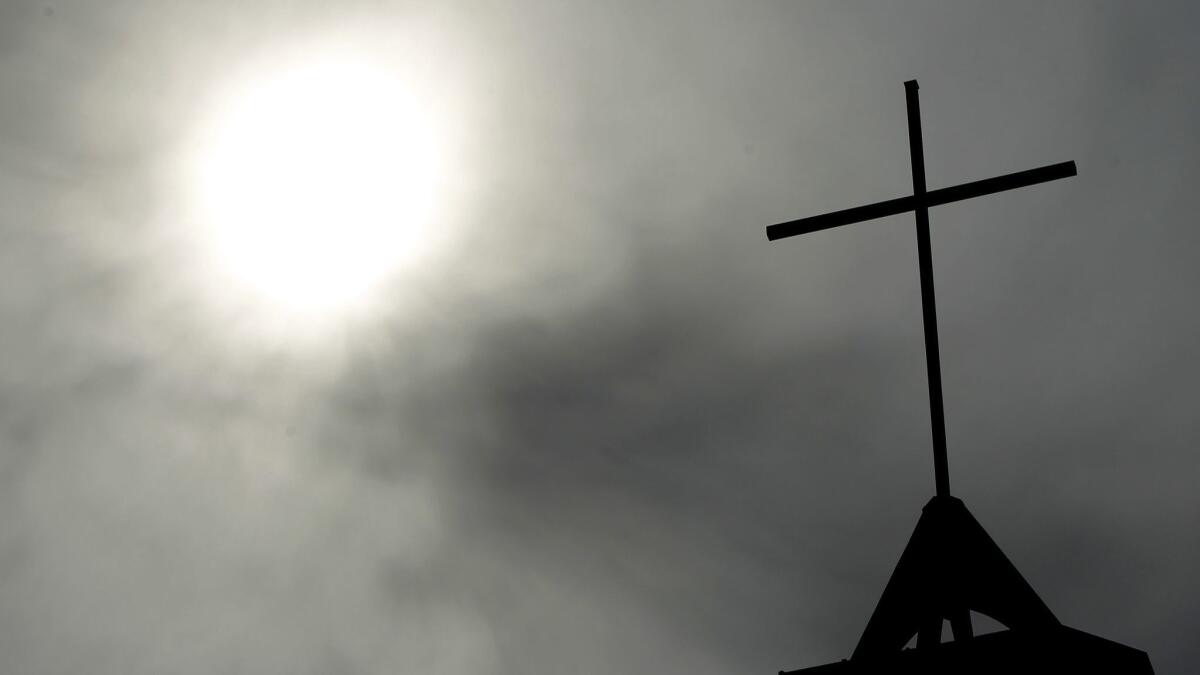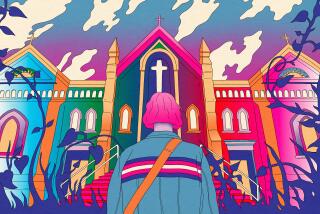Op-Ed: Why I am still a Catholic — and why that becomes more difficult every day

I am still a practicing Catholic.
To write that now seems to beg an explanation. How can I continue to profess the faith within the bounds of an institution so thoroughly corrupted by the gravest of sins? How can I accept the host from the hands of men who themselves may have abused, or covered up for those who did?
I owe my faith to my grandmother and the Virgen de Guadalupe. In her American life, my Mexican grandmother rarely set foot in a church, but she hung a huge, sepia-toned print of the virgin in her living room, a votive always aflame before it. It was the heart of the house, the image of a mother who would never waver in protecting her child. I am struggling to hold on to that image amid the nightmare of predator priests betraying the Mother Church.
Roman Catholics who lapsed long ago — and certainly many survivors of sexual abuse — may ask why it took me so long to reach this moment of reckoning.
The answer is I don’t know what my faith would be without my church. I don’t know what my life would be like without my faith. And despite the onslaught of scandal after scandal, I’ve held on to the hope that the crisis would somehow open up the possibility of a profound conversation about the church’s identity — including priestly celibacy, gender and sexual orientation. Indeed, there were hints at the beginning of Francis’ papacy that such a dialogue could take place. But the conversation — such a complicated one, among more than a billion faithful on every continent — never seems to gain momentum before another scandal hits.
When the pope and cardinals speak, they never seem to address the laity’s confusion and deep spiritual turbulence.
As I came of age and ran up against the moral conservatism of the church, I was still able to find a community among kindred spirits in the faith who fought the good fight — many of them members of the Jesuit order, which was at the forefront of social movements in the United States and Latin America in the 1970s and ’80s. There were plenty of moralizing homophobes in the church, but so too were there figures who followed the radical spirit of the Gospels, like Father Gregory Boyle, the famous “gang priest” of Boyle Heights, or Father Michael Kennedy, who was instrumental in establishing a sanctuary for refugees from Central America in the 1980s.
Then came the child sex abuse crisis. A decade ago, as hundreds of lawsuits were settled by dioceses across the country, it seemed possible the church had at least begun to recognize its responsibility to survivors, that healing could come. But new scandals kept erupting, here and around the globe, and last month Francis fell disappointingly short of committing to full transparency when he addressed the Vatican Summit on Child Protection.
Last Sunday, I visited my parish in Oakland for the first time since the arrival of a new pastor. I was keen on hearing what he might say about the just-concluded Vatican summit. Our new pastor hails from Mexico, as do most of the parishioners. In a generic homily, he invoked the Virgen de Guadalupe and invited the flock to double down on its faith. He made no mention whatsoever of the meeting in Rome, nor of survivors, nor of how many of us are struggling with the ceaseless revelations of corruption up and down the hierarchy. His silence felt like the silence of complicity. When my daughters and I approached the altar to take Communion, I was relieved that he wasn’t at the head of our line.
At my daughters’ parochial school, the principal, an energetic and earnest woman, welcomes us daily with this year’s affirmation. “Rejoice and be glad,” she says, to which the children respond, “Yours is the kingdom of God.” My daughters delight in reciting the prayers and singing the hymns of our faith, surely feeling something akin to what I did when I gazed up at the virgin in my grandmother’s house. On the cusp of their teenage years, they are more and more aware of the crisis. And now they hear their father expressing ambivalence about the church and our place in it. I am fully aware that I’m leading them toward what may amount to one of the greatest disillusionments of their formative years. At the very least, I know they will have to do some uncomfortable reckoning with the church as they mature.
Last week, I witnessed my students at Loyola Marymount University in Westchester, a Jesuit institution, doing their own reckoning. The class I teach is called Rhetorical Arts, a new addition to the core curriculum. In my section of the course I emphasize the idea of speaking out on social issues, which brought us inevitably to a discussion about the church. I had no idea how difficult it would be.
I passed out readings beforehand, including reports about the Vatican meeting. Also, to underscore the ubiquity of the crisis, I gave them an article about the recent release of names of Jesuit clergy implicated by credible allegations of sexual misconduct. Eleven of those on the list had at one time worked at LMU. Two were still alive.
The day of class, we met at the Laband Art Gallery on campus to see an exhibit titled “Confess” by the Irish artist Trina McKillen. The centerpiece of the show is a confessional made mostly of glass, behind which nothing can be hidden, nothing kept secret. The roles of confessor and penitent are reversed, too: The abusing priest is meant to kneel on a hassock of nails and ask forgiveness from a child survivor sitting on a white chair. It is a startling image that somehow conveys the hope that there may yet be a full accounting, perhaps even a healing to the trauma of generations.
When we finally sat down as a class to talk about it all, the conversation quickly turned chaotic. One student insisted the church would never change. “Why speak up?” he asked. “There will be no justice.” Others responded, vociferously, that the survivors must continue to speak, that there could be no healing without the rest of us hearing their stories. A few wondered aloud if they’d have to leave their spiritual home. One student came up to me after class and said he felt on the verge of a panic attack during the discussion.
Enter the Fray: First takes on the news of the minute »
In my three decades of teaching, it was the most difficult conversation I’d ever moderated. I’m still not exactly sure what I’m going to say the next time we meet.
What I do know is that my classroom was a reflection in miniature of the worldwide Catholic community in this searing moment.
When the pope and cardinals speak, they never seem to address the laity’s confusion and deep spiritual turbulence. They do not seem to understand that it feels to us like the church is disintegrating — and our faith with it.
Every night I lead my daughters in the prayers that my grandmother taught me, ending with the thumb and forefinger of my right hand making the sign of the cross over their heads. Last night, I hesitated as I did so, the cross hovering in the dark between us.
Rubén Martínez is a professor of English and Chicana/o studies at Loyola Marymount University. He is the author of “Desert America: A Journey Across Our Most Divided Landscape” and other books.
More to Read
A cure for the common opinion
Get thought-provoking perspectives with our weekly newsletter.
You may occasionally receive promotional content from the Los Angeles Times.










